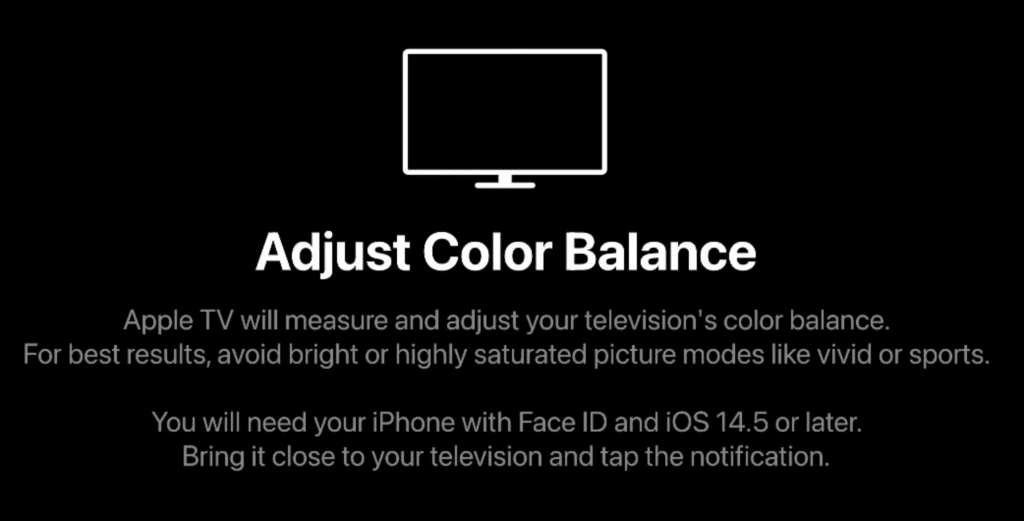
DIY AppleTV Color Calibration
Apple TV calibration is now possible with tvOS 14.5 and a recent model iPhone smartphone.
Now that Apple has fixed the remote, it is time for us to get the colors right!
This free feature works on the AppleTV HD version introduced in 2015 and all later models.
You’ll also need an iPhone X or newer that supports Face ID.
The Apple TV calibration process is really easy – just select “Color Balance” from the Apple TV settings Video and Audio menu and follow the on-screen instructions.
You’ll place your iPhone right up against the screen itself and hold it there while the AppleTV plays some color samples on the screen which the iPhone measures and reports back.
Using this information, the AppleTV will apply some color corrections to it’s output and show a “before” and “after” split screen.
You can choose to use the improved “after” changes or keep the original settings.
I’ve recorded a short video showing this in action.
What is color calibration?
In simplified terms, color calibration or color correction is a series of adjustments to the circuitry in a visual output or capture device to try and match way our eyes perceive color.
The goal of color calibration is to make what we see accurately reflect the real world.
So a red rose displayed in a video onscreen will look identical to seeing the red rose in real life.
When is color calibration used?
Color calibration is not just for streaming media boxes like the AppleTV. Any device that captures or displays images or video needs to be calibrated.
You may hear this used in describing cameras, televisions, optical scanners, computer monitors, and printers. Or other devices that capture or display static or moving images.
All of these devices need to be calibrated to account for manufacturing variations during production and other differences.
Modern TV’s, computer displays, and other devices are adjusted at the factory and are pretty accurate.
Unlike a game of horseshoes, close does not count when it comes to absolute color accuracy. You must make the Final adjustments manually when a device is setup and ready for use.
What affects TV color calibration?
In addition to the quality and capability of the hardware itself, many other factors affect color accuracy.
For TV viewing, the existing light in the room makes a big difference. Are you watching a movie in total darkness? Maybe you are watching during the daytime with natural sunlight coming in from the window? Is there light from lamps or overhead fixtures?
The content matters too. When you watch a Hollywood movie where the colors have been carefully corrected and adjusted by color technologists? Or are you just watching a home movie you just recorded on your smartphone?
Don’t forget the settings of your TV itself. Modern TV’s have picture modes that quickly change brightness, contrast, color tones, and even motion blur automatically. You’ll want to choose these carefully and turn most off.
What do professional TV calibrators do?
If you want the absolute best color quality and image from your TV, you can hire a professional calibrator.
These highly skilled technicians will come to your home bringing specialized equipment which can cost up to $20,000.
They’ll spend several hours measuring and adjusting many different color and technical settings of your TV to take it from great to awesome.
Usually, they don’t just do a single calibration. They will create multiple settings for different kinds of viewing and settings – movies, sports, daytime, or evening/complete darkness.
Limitations of Apple’s free color calibration
It’s fun to play with this new feature, but keep a few things in mind:
The TV you buy today is built with high quality components and the factory calibration is really good.
Calibration, whether using the DIY Apple method or calling in a professional, may provide only subtle changes that are hard to see.
Apple’s technique works by adjusting the signal output from the AppleTV box. It doesn’t change any of the actual TV settings themselves. So make sure you have your TV set to the most common picture mode before running the Apple process.
Because Apple adjusts the output from the AppleTV and doesn’t actually change the TV itself, this calibration will only work for what you watch from the AppleTV.
If you also have cable or satellite TV, other streaming media boxes, or a DVD or Blu-ray player, those sources will not be calibrated unless you have a professional calibrator adjust the TV itself.
